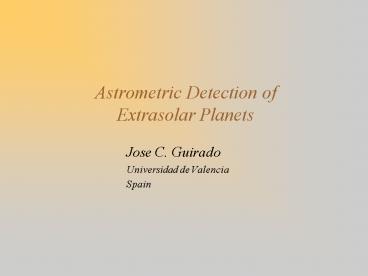Astrometric Detection of Extrasolar Planets - PowerPoint PPT Presentation
1 / 24
Title:
Astrometric Detection of Extrasolar Planets
Description:
Radial velocity is a very efficient technique. Astrometry is the technique of the past... Importat feature: FAST ROTATOR (0.5 days) ... – PowerPoint PPT presentation
Number of Views:161
Avg rating:3.0/5.0
Title: Astrometric Detection of Extrasolar Planets
1
Astrometric Detection of Extrasolar Planets
- Jose C. Guirado
- Universidad de Valencia
- Spain
2
Overview
- Capabilities of astrometry
- Capabilities of radio astrometry - SKA
- Technique cooperation the case for AB Dor
3
Planet Detection Score
Radial Velocity
Astrometry
120
2
?
- Radial velocity is a very efficient technique
- Astrometry is the technique of the past
- and the technique of the future
4
Astrometry
- Determination of 3D orbit. Unambiguous mass
determination. - (masses determined by Doppler techniques are
coupled with orbit inclination) - Young and active stars may be studied
- Sensitivity to longer periods (larger as)
- Expected very high-precision
- SIM (4µas) GAIA (10µas)
5
Mass vs. Separation
Radial speed limit 5 m/s
Wobble limit 1mas
Wobble limit 0.01mas
J. Liebert (2000)
6
Radio Astrometry
M. Perryman (2000)
SKA
7
Radio Astrometry
- Space-based expected (2010) very high-precision
in the optical - SIM (4µas) GAIA (10µas)
1983
5 ?as
8
Radio Astrometry
Treuhaft Lowe, AJ, 1991
Reid et al., ApJ, 1999
9
The S5 Polar Cap sample
- Flat spectrum radio sources
- 8 QSOs
- 5 BL-Lac objects
- Long-term astrometric program
- ? 3.6, 2, 0.7 cm
- Bootstrapping techniques
- Ros et al 2000
- Pérez-Torres et al 2004
10
The technique
- Phase-delay astrometry
- Phase-reference mapping
11
High resolution and astrometric precision
- Theoretical precision for an interferometer
- Sources of error
- F-extrapolation
- Differential contribution from atmosphere and
ionosphere - Structures of reference and target source
12
Sources of Error in AstrometrySolutions for new
instruments
- Multi-beam System
- F-extrapolation problem solved simultaneous
observation from target and reference - Different lines of sight tomography of the
atmosphere/ionosphere - removal of propagation
medium biases - On-the-fly mapping
- Removal of structure contribution of reference
(and target)
13
Sensitivity
A.R. Taylor (2000)
14
SKA Sensitivity and High Resolution
- Baselines of thousands of kilometers will match
the progress in sensitivity with the present VLBI
resolution - Sensitivities expected far below µJy/beam
- The F-referencing increases the integration time
from minutes to hours ? detection of weaker
sources
15
Search for Planets and Star Companions VLBI
Program
- Antennas at Effelsberg/Robledo/ Goldstone
- Single baseline 1 mas astrometric precision
- Search for companions in
- stars nearby the sun (10pc)
- small mass
- single (or wide separation binaries)
- with (some) radio emission
- dMe stars look the most suitable targets
16
Search for Planets and Star Companions VLBI
Program
- dMe stars look the most suitable targets
17
Search for Planets and Star Companions VLBI
Program
- dMe stars look the most suitable targets
18
Technique cooperation the case of AB Dor
- Very well known southern-hemisphere PMS star (mv
6.9) - Importat feature FAST ROTATOR (0.5 days)
- Broadening of the spectral lines, limiting
precision of Doppler techniques to 5km/s - Present radio emission via dynamo effect
19
Technique cooperation the case of AB Dor
- Very well known southern-hemisphere PMS star (mv
6.9) - Importat feature FAST ROTATOR (0.5 days)
- Broadening of the spectral lines, limiting
precision of Doppler techniques to 5km/s - Present radio emission via dynamo effect
0.08-0.11 M?
0.76 M?
Guirado et al. (1997, ApJ, 490, 835)
20
Orbit Determination
- Weighted-least-squares fit of the VLBIHIPPARCOS
positions to estimate simultaneously - 5 astrometric parameters
- 7 orbital parameters (Thieles-Innes method)
- Mass estimate (ABDor C)
- 0.08 0.11 M?
21
22
ABDor
ABDor C
ABDor
ABDor C
ABDor
23
(New) Orbit Determination
- Mass estimate (ABDor C)
- 0.08 0.11 M?
- Mass estimate (three techniques)
- 0.084 /- 0.004 M?
- Even a modest detection of the position of ABDorC
would lead to very precise determination of its
mass.
24
Summary
- The SKA will increase the observed radio stars
from hundreds to millions of objects - SKA in astrometric mode
- Link with the optical astrometric satellites
(SIM, GAIA) - Discovery of low-mass objects and exoplanets
- High resolution is needed to reach the highest
astrometric precision - Cooperation with other techniques is needed to
confirm or improve the detections.































